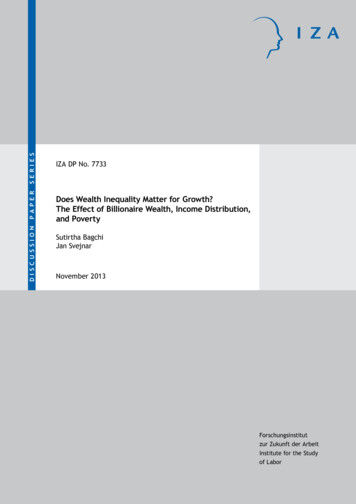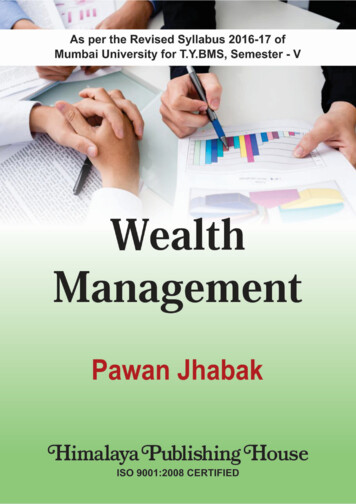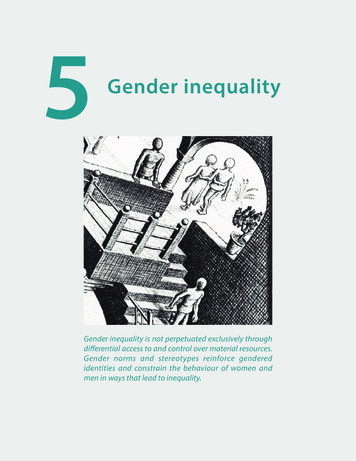
Transcription
SERIESPAPERDISCUSSIONIZA DP No. 7733Does Wealth Inequality Matter for Growth?The Effect of Billionaire Wealth, Income Distribution,and PovertySutirtha BagchiJan SvejnarNovember 2013Forschungsinstitutzur Zukunft der ArbeitInstitute for the Studyof Labor
Does Wealth Inequality Matter for Growth?The Effect of Billionaire Wealth,Income Distribution, and PovertySutirtha BagchiUniversity of MichiganJan SvejnarColumbia University,CEPR, IZA and CERGE-EIDiscussion Paper No. 7733November 2013IZAP.O. Box 724053072 BonnGermanyPhone: 49-228-3894-0Fax: 49-228-3894-180E-mail: iza@iza.orgAny opinions expressed here are those of the author(s) and not those of IZA. Research published inthis series may include views on policy, but the institute itself takes no institutional policy positions.The IZA research network is committed to the IZA Guiding Principles of Research Integrity.The Institute for the Study of Labor (IZA) in Bonn is a local and virtual international research centerand a place of communication between science, politics and business. IZA is an independent nonprofitorganization supported by Deutsche Post Foundation. The center is associated with the University ofBonn and offers a stimulating research environment through its international network, workshops andconferences, data service, project support, research visits and doctoral program. IZA engages in (i)original and internationally competitive research in all fields of labor economics, (ii) development ofpolicy concepts, and (iii) dissemination of research results and concepts to the interested public.IZA Discussion Papers often represent preliminary work and are circulated to encourage discussion.Citation of such a paper should account for its provisional character. A revised version may beavailable directly from the author.
IZA Discussion Paper No. 7733November 2013ABSTRACTDoes Wealth Inequality Matter for Growth? The Effect ofBillionaire Wealth, Income Distribution, and Poverty*A fundamental question in social sciences relates to the effect of wealth inequality oneconomic growth. Yet, in tackling the question, researchers have had to use income as aproxy for wealth. We derive a global measure of wealth inequality from Forbes magazine’slisting of billionaires and compare its effect on growth to the effects of income inequality andpoverty. We find that wealth inequality reduces economic growth, but when we control for thefact that some billionaires acquired wealth through political connections, the effect ofpolitically connected wealth inequality is negative, while politically unconnected wealthinequality, income inequality, and initial poverty have no significant effect.JEL Classification:Keywords:D31, O40, O43economic growth, wealth inequality, income inequality, billionaires,political connectionsCorresponding author:Jan SvejnarColumbia UniversitySchool of International and Public Affairs420 West 118th StreetNew York, NY 10027USAE-mail: js4085@columbia.edu*We thank (without implicating) Lakshmi Iyer, Scott Masten, Jagadeesh Sivadasan, Joel Slemrod,Dmitriy Stolyarov, and Dietrich Vollrath for helpful comments. We also thank seminar participants atHarvard Business School, Hong Kong University of Science and Technology, London BusinessSchool, the Midwest Economic Association Annual Conference, the Eastern Economic AssociationAnnual Conference, University of Michigan, and Wesleyan University for helpful comments.
1IntroductionA central question in the social sciences is whether inequality in control over a society’s resources facilitatesor hinders economic growth. Although there is a large theoretical and empirical literature on this topic, thequestion is far from settled.Three important features of the literature contribute to this lack of consensus. First, althoughtheoretical arguments are usually based on the distribution of wealth, nearly all empirical studies use thedistribution of income rather than wealth because data on the distribution of wealth do not exist for asufficient number of countries. As Aghion, Caroli and Garcia-Penalosa (1999: pp. 1617-18) explain, “. . .the absence of data on the distribution of wealth for a sufficient number of countries forces researchers touse proxies in empirical studies. The most common approach is to use data on income inequality as a proxyfor wealth inequality.” Bénabou (1996) echoes this point when he notes that the lack of almost any dataon the distribution of wealth is a general problem, given that in most theories it is this distribution ratherthan that of income which is the determinant of outcomes. Finally, while discussing studies that use incomeinequality, Ravallion (2012: p. 506) emphasizes that “wealth inequality is arguably more relevant thoughthis has been rarely used due to data limitations.”1Second, the literature does not adequately account for the sources of inequality. Consider Indonesiaand United Kingdom. Although these countries appear similar on measures of income inequality, theirrespective Gini coefficients being 32.5 and 33.7, they differ markedly on such dimensions as the role thatpolitical connections have played in achieving economic success and bringing about their distribution ofincome and wealth. Yet, virtually all empirical studies ignore this distinction and examine the effects ofaggregate measures of inequality on economic growth.2Third, in an important multi-country study, Ravallion (2012) has recently cast serious doubt oninequality as a determinant of growth, suggesting that it is initial poverty rather than income inequalitythat affects economic growth of countries.In this paper, we address the shortcomings noted in the first two points above and we provide newevidence on the third point, namely the issue of whether inequality or poverty affects growth. We firstdevelop a measure of wealth inequality based on Forbes magazine’s annual world-wide listing of billionaires.Second, we introduce two new variables reflecting the extent, if any, to which billionaire wealth has beenobtained through political connections (cronyism). We next use annual data for 1987-2007 to constructfour five-year panels and test hypotheses regarding the effects on growth of our overall measure of wealthinequality, our measures of politically connected and unconnected wealth inequality, income inequality, andpoverty. To the best of our knowledge, ours is the first paper to examine the effect of wealth inequality on1 The only study that directly uses wealth inequality data and looks at the effect of wealth inequality on growth is a paper byRavallion (1998) who studies the effect of geographic differences in the distribution of wealth on growth in China and finds evidencethat high wealth inequality impedes growth.2 Easterly (2007) is a notable exception in that he distinguishes between structural and market-based inequality. A fuller discussionof the relationship between his paper and our work is provided in sections 2 and 4 below. Moreover, as we discuss below, Morck,Stangeland, and Yeung (2000) note that when they divide billionaires into those who were self-made versus those who inherited theirwealth, a country’s per capita GDP grows faster if its self-made billionaire wealth is larger as a fraction of GDP and slower if inheritedbillionaire wealth is larger as a fraction of GDP.2
economic growth in a cross-country, panel data setting, and also the first study to estimate an encompassingmodel that compares the effects on growth of wealth inequality, income inequality, and poverty.3We also tackle a methodological criticism of much of the literature in this area, namely that findingsmay be biased on account of endogeneity of inequality in the growth regressions. We follow one of the leadingempirical studies in this area - Forbes (2000) - and estimate a fixed effects model with lagged values of theexplanatory variables. In addition, while finding valid instruments for traditional instrumental variable(IV) estimation is very difficult in this setting, we also discuss estimates based on two time-varying IVs forwealth inequality.Our first finding is that wealth inequality has a negative, statistically significant effect on economicgrowth, while the effect of income inequality is insignificant or only borderline significant, and the effectof poverty is statistically insignificant in all specifications. Hence, using an encompassing model, we showthat in the head-on comparison it is wealth inequality, rather than income inequality or poverty that has asignificant effect on economic growth.Our second set of results comes from specifications in which we control for the fact that some billionaires acquired wealth through the use of political connections or cronyism, while others obtained it ina relatively standard legal environment. This estimation is based on a categorization of billionaires that issomewhat subjective.4 We are conservative about classifying someone as being politically connected and arealso fully up-front about how we carry out the classification. Using the classification, we find that the effectof politically connected wealth inequality on growth is negative, while the effects of politically unconnectedwealth inequality, income inequality, and initial poverty are statistically insignificant. The second set ofresults hence suggests that one needs to pay attention to the sources and nature of wealth inequality.Our third set of results shows that our estimates are robust to a number of alternative specificationsand explores the reason why our results with respect to income inequality differ from those of Forbes (2000)and those with respect to poverty from those of Ravallion (2012).The structure of the paper is as follows. In Section 2, we offer a brief review of the theoretical andempirical literature that examines the impact of inequality and poverty on growth. In section 3, we presentour empirical strategy and describe the data set used. In Section 4, we validate the use of the inequalityvariables constructed from Forbes magazine’s annual listing of billionaires as reasonable measures of wealthinequality and the importance of political connections in a country’s socioeconomic system. In section 5, wepresent the main results capturing the impact of wealth inequality (and its components), income inequality,and poverty on growth. We also report a number of robustness checks that show that our findings are robust.Section 6 offers concluding remarks and outlines potential avenues for future work.3 As we discuss below, a pioneering study by Alesina and Rodrik (1994) and an important later study by Deininger and Olinto (2000)use land inequality as a proxy for wealth inequality, but this measure is more appropriate for low income agrarian societies than theworld as a whole.4 This is in the same vein as the Corruption scores of the International Country Risk Guide (ICRG) of the University of Maryland, Transparency International’s Corruption Perceptions Index, and Fisman’s classification scheme (2001) which are also based onperceptions rather than on objective data.3
2Review of the existing literatureThe early view espoused by Kuznets (1955) and Kaldor (1956, 1961) was that economic development affectsincome distribution, with growth increasing income inequality in the first stages of economic developmentand reducing it later (the ‘inverted-U hypothesis’). Kuznets’ hypothesis has been extensively tested andgenerally has been found to lack empirical support (see, e.g., Fields, 2001 for a review).In the more recent literature on growth and development the causation between inequality andgrowth runs in the opposite direction.5 The focus is on the effect of wealth inequality and to a lesser extentincome inequality on economic growth, with the theoretical literature yielding two main strands of studies.The first strand suggests various transmission mechanisms through which greater initial inequality fosterseconomic growth. Prominent among them is a higher savings propensity of the rich (Bourguignon, 1981) andinvestment indivisibilities (Attanasio and Binelli, 2003). The other strand identifies economic and politicalchannels through which inequality may be harmful for growth. These include redistributive taxation thatwould be favored by the median voter and which would reduce incentives and hence also growth (Meltzerand Richard, 1981; Alesina and Rodrik, 1994; Barro, 1999), credit constraints generated by low levels ofcollateral by the poor (Galor and Zeira, 1993), sociopolitical instability stemming from the sense of relativedeprivation by the poor (Gupta, 1990), and increased fertility among the poor who cannot afford to provide human capital to their children (De La Croix and Doepke, 2003). The idea common to many of theseconceptual frameworks that expect a negative effect of wealth inequality on growth is that extreme wealthconcentration distorts economic policies and therefore leads to poor economic performance.As mentioned earlier, the absence of data on the distribution of wealth for a sufficient number ofcountries has led empirical researchers to rely on alternatives, typically by using data on income inequalityas a proxy for wealth inequality. Two partial exceptions are a pioneering study by Alesina and Rodrik(1994) and an important later study by Deininger and Olinto (2000) that use land holdings as a measureof wealth inequality. However, as Alesina and Rodrik (1994) note, land is only one component of wealthand moreover, land does not exactly fit their model’s notion of capital as an accumulating asset. In addition,while inequality in land holding may be appropriate for poor agrarian economies, it is not an adequate proxyfor wealth inequality in more developed economies.6 In addition, our calculations based on the 26 countriesfor which data exist indicate that there is no correlation between the Gini coefficient for land (sourced fromDeininger and Olinto (2000)) and Gini coefficient for wealth, nor do we find a correlation between the 20countries for which we have data on the Gini coefficient for land and the share of wealth going to the topdecile of the population of a country.7 In contrast, our measure of billionaire wealth normalized by GDP ispositively correlated with the Gini coefficient for wealth and the share of wealth going to the top decile.5Areview of this literature may be found in Aghion, Caroli, and García-Peñalosa (1999), Ehrhart (2009), and Galor (2009).a study of income tax returns by Bakija et al. (2012) suggests, professionals account for an overwhelming share of the top 1percent of income earners in the U.S.: 31 percent started or manage nonfinancial businesses, about 16 percent are doctors, 14 percentare a part of the financial services industry, 8 percent are lawyers, 5 percent are scientists and engineers, and about 2 percent area part of the sports, entertainment or media industries. It would be hard to argue that for such individuals, their holdings of landcapture, to any reasonable degree, their asset holdings.7 Both measures of wealth inequality are sourced from Davies et al. (2008).6 As4
Interestingly, as Davies et al. (2008) point out, “in all countries which have the requisite data, wealthdistribution is more unequal than income.” This raises the question as to whether the estimated effect ofincome inequality on growth truly captures the impact of wealth inequality on growth and it provides onemotivation for our study.The empirical literature dealing with income inequality and economic growth is based on crosscountry regressions and, more recently, on panel data analysis. While cross-country regressions examinethe long-run relationship and generally find a negative impact of income inequality on growth (see e.g.,Alesina and Rodrik, 1994, Persson and Tabellini, 1994, and Perotti, 1996), panel data estimates aim atmeasuring the short and medium-term relationship and they obtain mixed evidence (see e.g., Forbes, 2000and Barro, 2000).A possible reconciliation of the opposing views on whether inequality has a positive or negativeimpact on growth is made by Easterly (2007: 756) who notes:One confusion in the theoretical and empirical analysis of inequality is between what we could callstructural inequality and market inequality. Structural inequality reflects such historical events as conquest, colonization, slavery, and land distribution by the state or colonial power; it creates an elite by meansof these non-market mechanisms. Market forces also lead to inequality, but just because success in freemarkets is always very uneven across different individuals, cities, regions, firms, and industries. So therecent rise in inequality in China is clearly market-based, while high inequality in Brazil or South Africais just as clearly structural. Only structural inequality is unambiguously bad for subsequent developmentin theory; market inequality has ambiguous effects — it could have some of the adverse effects cited in theabove models, but eliminating it would obviously have negative incentive effects.As we discuss later, our first step toward quantifying the importance of political connections goes in thedirection of operationalizing Easterly’s notion of structural inequality.Finally, an important motivation for our study comes from Morck, Stangeland, and Yeung (2000)who find that when they divide the world’s billionaires into those who were self-made versus those whoinherited their wealth, a country’s per capita GDP grows faster if its self-made billionaire wealth is largeras a fraction of GDP and slower if inherited billionaire wealth is larger as a fraction of GDP. They argue thatthe deleterious consequences of having the very wealthy control a very large fraction of a country’s assets canlead to entrenchment, bias capital allocation, retard capital market development, obstruct entry by outsiderentrepreneurs, and cumulatively retard economic growth. These observations lead Morck, Wolfenzon, andYeung (2005) to speculate that “inequality involving new money wealth seems different from inequalityinvolving old money wealth.” They suggest that “economists need to think less about concentration of wealthper se and more about concentration of wealth in whose hands.”We use this finding as our point of departure in analyzing the relatively unexplored area of the effectof different sources and nature of wealth inequality on growth. In particular, many countries that generated low rates of economic growth were also characterized by a high level of wealth concentration amongentrenched elites, frequently politicians and their cronies. The negative correlation between inequality and5
growth in a cross-section of countries could thus have more to do with the fact that a large share of thenational wealth is held by a small number of politically connected families than with higher tax rates orhigher expenditure on transfers and subsidies, which are among the channels through which inequality isoften believed to affect growth.The literature on the effect of poverty v. income inequality on economic growth is represented byan important contribution by Ravallion (2012) who uses country-level data based on household surveys toexamine the effect of initial poverty and income distribution on subsequent economic growth. His datasetcovers 90 countries with two surveys at varying points in time, and most of the estimation is hence carriedout in a cross-sectional setting. For about two-thirds of the countries, there are three or more surveys andthese countries are used for robustness checks, including the GMM estimation and allowing for countryfixed effects. Ravallion’s (2012) key cross-sectional result, obtained in an OLS model, is that poverty ratherthan income inequality affects growth and that the effect of poverty on growth is negative. Moreover, hefinds that this result holds in the GMM model but vanishes in the specification with country fixed effects.3Data and Empirical Approach3.1Construction of data on Wealth InequalityThe key new source of data that we use is Forbes magazine’s annual listing of billionaires. Although Forbeshas been publishing a list of the four hundred richest Americans since 1982, it was only in 1987 that itexpanded its coverage to the richest individuals and families around the world.8 We use this latter listand assign each billionaire to a country based on the locus of his business activities, which often coincideswith his location. We generate three measures of wealth inequality defined for each year as the sum of thewealth of all the billionaires in a given country divided by either the country’s GDP or physical capital stockor population.9 Our first measure parallels that reported by The Economist (2012) for several countries andin section 4.1 we show that our three measures are correlated with other measures of wealth inequality.Because of the nature of construction of our wealth inequality variables, we focus on the effectsof concentration of wealth at the top of the wealth distribution pyramid. Our paper hence belongs to theclass of studies that examine inequality via the concentration of wealth or income in the top quantilesrather than taking into account the entire distribution (e.g., Davies et al., 2008, Piketty and Saez, 2003and 2010, and Wolff, 2006). Focusing on the top of the distribution is useful because over the last severaldecades concentration of income and wealth at the top has increased (e.g., Piketty and Saez, 2003, and TheEconomist, 2012). It is also widely believed that this concentration affects economic and social outcomes(e.g., Stiglitz, 2012), and in a number of countries, including the United States and France, government taxpolicies have been focused on this group. Finally, as Voitchovsky (2012) notes, inequality in different parts8 Thelist of countries that appear on the Forbes’ billionaire list in each year is provided in the Data Appendix A.2.billionaire wealth, GDP, and physical capital stock are expressed in nominal terms, the ratio of billionaire wealth to GDP orbillionaire wealth to physical capital stock should not exhibit any secular trends because of inflation.9 As6
of the income distribution has different effects on growth and a single inequality statistic for the entiredistribution is insufficient to capture the effects of inequality on growth. Our results may therefore be seenas reflecting the impact on growth of wealth inequality at the top of the distribution.The second prong of our analysis focuses on examining the prediction that the effect of wealth inequality on growth depends on whether wealth has been acquired through political connections. We identifythe fraction of billionaire wealth that has been generated through the use of political connections by classifying each billionaire into one of two categories: those who benefited from political connections and those whodid not. We start by creating a dummy variable called “Political connections” and set it equal to 1 when weconclude through an extensive search on Factiva and LexisNexis using news sources from around the worldthat political connections had a material part to play in the success of the billionaire. We set this variableequal to 0 when we conclude that political connections have not been crucial to the billionaire’s rise to richeseven though he may have had prior political connections. The criterion we use for classifying billionaires ashaving benefited from political connections is that our extensive review of evidence indicates that the personwould not have become a billionaire in the absence of political connections that resulted in favoritism and/orexplicit government support.10 Three examples of billionaires who are classified as politically connected areprovided in the Data Appendix A.3. A full classification of billionaires into the two categories of politicallyconnected and politically unconnected is available from the authors on request.As our discussion indicates, our measure is conservative in that only individuals who quite clearlybenefited from political connections as a means of becoming billionaires are included in the politically connected category. In fact, in classifying billionaires into the two categories, we distinguish between alteringthe playing field to benefit a particular individual or group of individuals from a generally pro-businessregulatory environment. Thus for instance in Hong Kong or Singapore, all businessmen and entrepreneursbenefit from the pro-business administrations.11 This is different from the case of, say, Indonesia, whereduring the Suharto regime it really mattered whether one knew Suharto because that could make all thedifference between obtaining a potentially lucrative import license or not (Mobarak and Purbasari, 2005).Or consider the case of Russia, which did not have a single billionaire until 1996, when we observe a sudden spurt in their number on account of the large-scale privatization of state assets that took place as partof Boris Yeltsin’s re-election as President. In these cases, after the review of news sources from aroundthe world, we conclude that these individuals profited from ties to politicians and would not have been billionaires without their support. Only in such cases do we classify billionaires as politically connected. Inour sample, politically connected billionaires account for anywhere between 4% and 13% of total billionairewealth, depending on the year under consideration.12It turns out that countries where entrenched elites control a large fraction of the country’s resources10 Weclassify a billionaire as politically connected if either the person who originated the wealth benefited from political connectionsor if the person who was growing the wealth benefited from political connections.11 In the 2011 Annual Report of Economic Freedom of the World (Gwartney, Hall, and, Lawson, 2011), Hong Kong and Singaporeenjoy the highest rating for economic freedom, a distinction they have held in every single year the report was generated since 1990(pp. 82 and 141).12 By this measure, the countries with the highest level of politically connected wealth inequality are Malaysia, Colombia, Indonesia,Thailand, and Mexico.7
are also likely to be countries where a large fraction of billionaires have reached their status through thereliance on such political connections. In Section 4.2, we offer evidence that our measure of politicallyconnected billionaire wealth is a reasonable proxy for the importance of political connections in a countryby showing that it is highly correlated with two widely used measures of corruption and an instrumentdeveloped in Easterly (2007).Overall, while our classification of billionaires into politically connected and politically unconnectedmay be viewed as being subjective, we note that the two most widely-used measures of corruption (the Corruption scores of the International Country Risk Guide (ICRG) of the University of Maryland and Transparency International’s Corruption Perceptions Index) are also based on perceptions rather than on objectivedata.13 Perception is also at the heart of the classification scheme employed by Fisman (2001) in that hismeasure of the importance of political connections to firms in Indonesia is based on “the subjective assessments of a number of top consultants.”14 Finally, we reiterate that our primary finding – the effect of wealthinequality on economic growth – is independent of our classification of billionaires into politically connectedor unconnected.Our panel begins in 1987, the first year in which the Forbes magazine’s list of billionaires fromaround the world was published. Replicating the 5-year panel structure in Forbes (2000) implies usinglists from years 1987, 1992, 1997, and 2002. We do so, but because Forbes magazine changed its editorialcriteria for inclusion in its billionaire list for the period 1997 to 2000, we substitute billionaire informationfrom 1996 for 1997. Further details regarding the construction of the wealth inequality variable and therobustness of results to using the 1997 list instead of the 1996 list are provided in the Data Appendix A.1.The unit of observation in our sample is a country-(5 year) period combination. We supplement thesample that corresponds to the data from the Forbes magazine with countries that do not have billionairesbut for which data on all other variables are available. We use these countries in our base regressions andassign them a value of zero for billionaire wealth inequality and its components. Assigning a value of zero isreasonable given the comprehensive nature of Forbes magazine’s coverage of billionaires. The inclusion ofthese additional countries brings the number of country-period observations to 395, of which 269 correspondto the absence of any billionaires and 126 correspond to the presence of billionaires.15 Summary statisticsfor the Forbes’ billionaire data for these 126 country-period observations are provided in Table 1.[Table 1 about here.]As may be seen from the Table, the number of countries on the Forbes’ list grows over time. Whileonly 23 countries appear on the first list in 1987, 41 countries appear on the list by 2002. The average13 TransparencyInternational describes it thus: “There is no meaningful way to assess absolute levels of corruption in countries orterritories on the basis of hard empirical data. Capturing perceptions of corruption of those in a position to offer assessments of publicsector corruption is the most reliable method of comparing relative corruption levels across countries.”14 Of the individuals that Fisman (2001) rates as having the highest level of political connections in Indonesia, two (Liem Sioe Liongand Prajogo Pangestu) show up on the billionaire lists. In both cases, we also independently classify these individuals as politicallyconnected based on our research using Factiva and LexisNexis.15 We lose 8 of the 134 coun
The Effect of Billionaire Wealth, Income Distribution, and Poverty . Sutirtha Bagchi . University of Michigan . Jan Svejnar . Columbia University, . wealth, a country’s per capita GDP grows faster if its self-made billionaire wealth is larger as a fraction of GDP and slower if inherited billi










